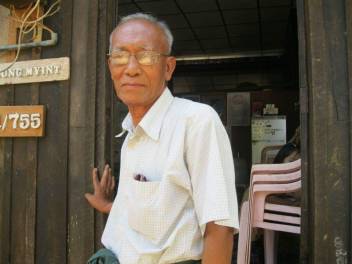 In a stilted wooden house in East Dagon township, an hour from Yangon, twenty older people are meeting together to discuss the issues that matter most to them.
In a stilted wooden house in East Dagon township, an hour from Yangon, twenty older people are meeting together to discuss the issues that matter most to them.
This is just one of more than 100 Older People’s Self Help Groups (OPSHGs) established with support from HelpAge Myanmar.
I was there to learn about older people’s main health concerns. And the message is clear. Many of them have high blood pressure, and almost everybody knows someone who has suffered a stroke. High blood pressure, also known as hypertension, is a major risk factor for heart disease, one of the leading non-communicable diseases (NCDs).
Rapidly ageing population
Myanmar’s population is ageing rapidly and the spread of NCDs is accelerating sharply. All ages are at risk of NCDs in Myanmar but older people are often disproportionately affected. Approximately 9% of the population are over 60, with projections that this will rise to 12% by 2025, accelerating the increase in NCDs.
NCDs tend to develop throughout the lifecourse, often occurring in older age as a result of exposure and risk over a number of years. It takes regular contact with health services to detect them. Also, due to their chronic nature, NCDs often affect whole families and communities causing catastrophic financial and social burdens.
The WHO estimates that NCDs already account for 40% of all deaths in Myanmar, and this figure is growing rapidly. NCDs made up four of the ten most common causes of death in 2010. One recent study reported a hypertension prevalence of 34%; with only one in ten controlling their blood pressure. Rates of diabetes and kidney disease have also doubled in the last twenty years, partly due to a lack of screening and treatment facilities.
Growing prevalence of NCDs
The growing NCD prevalence is striking: it highlights a vital gap in the health system. So far, most development assistance has focused on the burden of infectious diseases and maternal and child health. While this must continue, Myanmar is changing, and alongside social, economic and political shifts is a “disease transition” towards an increasing burden of NCDs.
This is against a background of decades of neglect and underinvestment in the health system, with few opportunities to develop technical expertise and capacity, particularly in relation to NCDs and mental health. Data on NCDs and mental health is sparse and while health budgets are growing, there is some way to go.
In order to help address these issues, HelpAge has launched a four-year, €3.5 million project in Myanmar. This EC-funded project is designed to build public health capacity, strengthen evidence-based policy and improve health services. We partner with Myanmar’s only public health body, the University of Public Health, along with the University of Medicine 2, and Thammasat University in Thailand.
Tackling NCDs goes beyond health sector
The project is a unique opportunity to support knowledge transfer and best practice while bringing together diverse sectors to find shared solutions that achieve policy change. A “health in all policies” approach recognises that effective action to tackle the NCD burden stretches beyond the health sector.
Traditionally, policies have put the onus on changing the behaviour of the individual, concentrating on four modifiable behavioural risk factors to prevent NCDs – tobacco, alcohol, diet and physical exercise. In fact, an effective strategy for NCDs must equally recognise environmental exposures, and the structural drivers of economic, trade, and environment policy, which have a huge bearing on health.
This is especially resonant at a time when Myanmar is opening its doors to foreign investment. In recent weeks KFC became the first US fast-food company to open for business in the country. Greeted by three-hour queues, the transnational food industry is hot on the heels of the tobacco, alcohol and soft drink industries, all of which have recently established multimillion pound investments. Reportedly, one eager diner claimed – “it is internationally famous, so I think it must be healthy.”
Protecting health
To me, there has never been a better opportunity to examine the role of legislative and regulatory mechanisms to create enabling environments and protect people’s health. The project will promote policy dialogue and consultation at all levels, bringing together representatives from grassroots actors to high-level decision makers.
The aim is to equip policymakers with strong evidence in order to make fully informed decisions about future investment. Training the next generation of public health and medical professionals by reforming the curriculum to reflect the realities is a component that is vital for sustainability.
As Myanmar continues to change there are opportunities like never before. This is an unprecedented chance to partner with national institutions to build capacity and systems. Responding to the rapid disease transition with projects like this is crucial to improving the quality of life for the people of Myanmar.
Read more about our work supporting older people in Myanmar.
